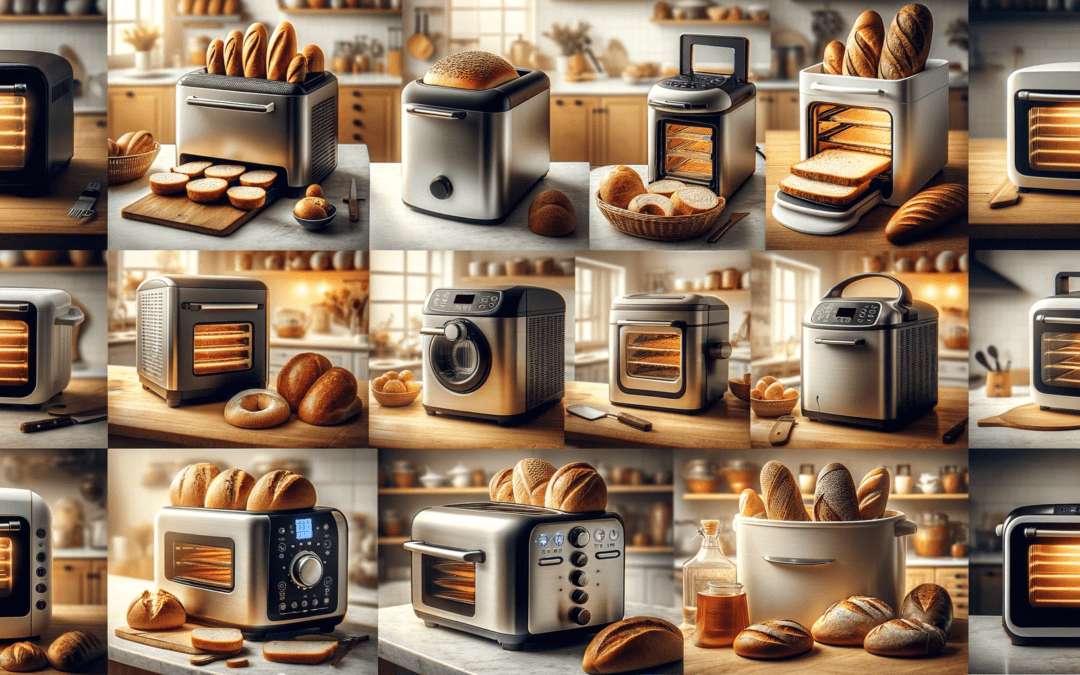1. Zojirushi Home Bakery Virtuoso Plus Breadmaker (Amazon)
- Key Features: Dual kneading blades, Gluten-free setting, Customizable settings
- Pros: Excellent kneading action, Consistent baking results, User-friendly interface
- Cons: Higher price point, Bulky design, Lengthy cycle times
- Description: The Zojirushi Home Bakery Virtuoso Plus is a top-of-the-line breadmaker, perfect for those who are serious about their home baking. It stands out with its dual kneading blades that ensure thorough dough mixing and rising. This machine is not just versatile, accommodating gluten-free and custom recipes, but also user-friendly, thanks to its intuitive control panel and LCD screen. While its size might be a bit bulky for smaller kitchens, and the price point is on the higher end, the investment is justified by the consistent, high-quality bread it produces.
2. Cuisinart CBK-110 Compact Automatic Bread Maker (Amazon)
- Key Features: 12 preprogrammed menu options, Compact size, 13-hour delay start
- Pros: Space-saving design, Easy to operate, Variety of settings
- Cons: Limited loaf size, Noisy during operation, Basic features only
- Description: The Cuisinart CBK-110 is ideal for those with limited kitchen space, offering a range of baking options in a compact footprint. With 12 preprogrammed settings, it’s capable of baking a variety of bread types. Its 13-hour delay start is a convenient feature, allowing you to wake up or come home to fresh bread. While it’s a more basic model and can be a bit noisy, it’s an excellent choice for beginners or those who prefer a straightforward, no-frills bread baking experience.
3. Breville Custom Loaf Bread Maker (Amazon)
- Key Features: Automatic fruit and nut dispenser, 13 settings, Customizable crust settings
- Pros: Innovative features, Durable construction, Versatile bread settings
- Cons: Expensive, Large footprint, Can be complex for beginners
- Description: The Breville Custom Loaf Bread Maker excels in innovation with features like its automatic fruit and nut dispenser. This machine offers 13 settings and allows you to customize your crust color. While its price tag and size are considerable, the versatility and durability it offers make it a worthwhile investment for those who bake regularly and enjoy experimenting with different recipes and ingredients.
4. Panasonic SD-YD250 Automatic Bread Maker (Amazon)
- Key Features: Yeast dispenser, Several bread options, Crust control
- Pros: Consistent results, Easy to use, Quiet operation
- Cons: No viewing window, Limited in loaf size customization, Older model design
- Description: The Panasonic SD-YD250 stands out with its automatic yeast dispenser, ensuring perfect bread every time. This machine is revered for its consistency and ease of use, making it a great choice for all levels of bakers. While it lacks a viewing window and offers limited loaf size customization, its quiet operation and reliable performance make it a solid choice for everyday bread making.
5. Hamilton Beach Artisan Dough & Bread Maker (Amazon)
- Key Features: Artisan dough setting, 14 programmed cycles, 3 loaf sizes and 3 crust shades
- Pros: Versatile dough options, Easy to clean, Affordable
- Cons: Inconsistent baking at times, Basic interface, Limited customizability
- Description: The Hamilton Beach Artisan Dough & Bread Maker is a budget-friendly option that doesn’t compromise on versatility. It’s especially good for those who love making artisan doughs. With 14 programmed cycles and options for different loaf sizes and crust shades, it offers flexibility. However, it may produce inconsistent results occasionally and has a more basic user interface. Overall, it’s a great entry-level machine for those exploring the world of bread making.
6. Oster Expressbake Bread Maker (Amazon)
- Key Features: 13-hour programmable baking timer, Express bake setting, Large viewing window
- Pros: Fast baking cycle, User-friendly, Large capacity
- Cons: Noisy operation, Limited crust color options, Basic design
- Description: The Oster Expressbake is designed for those who need bread in a hurry, offering a rapid bake cycle that delivers bread in under an hour. Its large viewing window and user-friendly controls make it a popular choice. While it can be noisy during operation and offers limited options for crust customization, its capacity to produce up to a 2-pound loaf makes it suitable for families and frequent bakers.
7. Sunbeam Programmable Bread Maker (Amazon)
- Key Features: 12 cooking functions, ExpressBake cycle, Large LCD display
- Pros: Affordable, Easy to use, Consistent performance
- Cons: Basic functionality, Bulky for small kitchens, Noisy operation
- Description: The Sunbeam Programmable Bread Maker is a reliable and affordable option for everyday baking. It offers 12 cooking functions and an ExpressBake cycle for quick results. Its large LCD display enhances ease of use. While it may lack advanced features and be a bit bulky and noisy, it’s a solid choice for those who want a straightforward bread making experience without a hefty price tag.
8. KBS Pro Stainless Steel Bread Machine (Amazon)
- Key Features: 17 programs, Automatic nut dispenser, 15-hour delay timer
- Pros: Wide variety of programs, Stylish design, High customizability
- Cons: Complex interface, Larger footprint, Pricier than basic models
- Description: The KBS Pro Stainless Steel Bread Machine is a sleek and versatile choice, offering 17 different programs and a handy automatic nut dispenser. Its 15-hour delay timer adds convenience for scheduling your baking. The machine’s stylish design is matched by its high level of customizability, making it ideal for those who like to experiment with their recipes. However, its interface can be complex for beginners, and it’s one of the pricier options on the list.
9. Breadman 2 lb Professional Bread Maker (Amazon)
10. SKG Automatic Bread Machine (Amazon)
- Key Features: 19 automatic programs, 15-hour delay timer, 3 loaf sizes
- Pros: Wide range of programs, Compact and sleek design, Easy to operate
- Cons: Inconsistent crust browning, Limited customizability, Basic features only
- Description: The SKG Automatic Bread Machine is a compact option that doesn’t skimp on features, offering 19 automatic programs and a 15-hour delay timer. Its sleek design is a great fit for modern kitchens. While it’s easy to operate, some users have found the crust browning to be inconsistent, and it offers only basic features. Nevertheless, it’s a good choice for those who want a variety of programs in a smaller machine.
FAQ’s
1. What are the key features to look for when choosing a bread making machine?
When selecting a bread making machine, it’s essential to consider several key features that will impact the quality, convenience, and versatility of your bread making experience. Firstly, consider the machine’s loaf capacity, which determines the size of the bread you can bake – options typically range from 1 to 2.5 pounds. Next, evaluate the number of settings available, such as different dough types (white, whole wheat, gluten-free, etc.) and crust colors (light, medium, dark). The delay timer feature is also beneficial for scheduling bread making in advance. Additionally, a viewing window is a handy feature to monitor the progress without opening the machine. Lastly, consider the ease of cleaning, particularly whether the machine has a non-stick bread pan and kneading paddles, and if these parts are dishwasher safe.
2. How do bread making machines work and what is the typical process for baking a loaf?
Bread making machines simplify the bread-making process by automating the mixing, kneading, rising, and baking stages. The typical process starts with adding ingredients to the bread pan in the recommended order (usually liquids first, then dry ingredients, and yeast last). Once the ingredients are in, you select the desired program based on the type of bread and crust color. The machine then begins the cycle by mixing the ingredients and kneading the dough. After kneading, the dough is left to rise inside the machine, which maintains an optimal temperature for yeast growth. Finally, the machine bakes the bread with controlled heating elements. The entire process can take anywhere from 2 to 4 hours, depending on the selected program.
3. Can bread making machines make other types of food besides bread?
Yes, bread making machines are versatile appliances that can be used to make a variety of foods besides bread. Many machines come with settings for preparing pizza dough , pasta dough, and even gluten-free options. They can also be used to make jams, cakes, and some models have settings for making yogurt or fermenting dough. The dough-only setting is particularly useful for shaping and baking dough in a traditional oven, allowing for more variety in shapes and sizes, like baguettes or rolls. This versatility makes bread making machines a multifunctional addition to any kitchen, offering a range of culinary possibilities beyond just baking bread.
4. What are the advantages of using a bread making machine compared to traditional bread baking methods?
Using a bread making machine offers several advantages over traditional bread baking methods. Firstly, it provides convenience and time-saving benefits. The automated process allows you to add ingredients, select a program, and then attend to other tasks while the machine does all the work. This is particularly advantageous for busy individuals or those who lack traditional bread-making skills. Secondly, it ensures consistency in the bread’s quality and texture, as the machine precisely controls mixing, kneading, rising, and baking times. Thirdly, it offers versatility with various settings for different types of bread and dough. Additionally, bread machines are generally more energy-efficient than conventional ovens and can be a more economical option in the long run. Lastly, they offer a cleaner and more contained baking process, reducing the mess typically associated with traditional bread baking.
5. How do you maintain and clean a bread making machine to ensure its longevity and performance?
Maintaining and cleaning a bread making machine is crucial for its longevity and performance. Firstly, always unplug the machine and let it cool down before cleaning. The bread pan and kneading paddles should be removed and cleaned after each use. Most bread pans and paddles are non-stick and dishwasher safe, but hand washing with warm, soapy water is often recommended to prolong their life. Avoid using abrasive cleaners or scrubbers on these parts. The interior of the machine should be wiped with a damp cloth to remove any flour or crumbs, and the exterior can be cleaned with a soft, dry cloth. Periodically check the kneading paddles and drive shaft for any residue buildup, and ensure they move freely. Regular cleaning and proper care will not only extend the life of your bread making machine but also ensure that it consistently produces high-quality bread.











